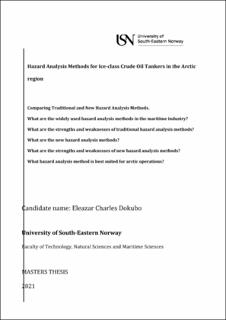| dc.description.abstract | With the visible effects of global warming staring right at us, it is difficult to deny the inevitable truth that global warming is here and its effect in the Arctic is evident. Nevertheless, the rapid thinning of the ice covering opens up the possibilities for new sailing routes, mining and drilling, and exploration. The objective of this master’s thesis paper is to explore hazard analysis in reference to tankers vessels sailing in the Arctic. Various hazard analysis methods exist in the industry, but which is best suited for tanker vessels operating in the Arctic region. Using qualitative research design method and through the aid of the exploratory method, this thesis aims to study and understand the different methods used in hazard analysis.
This thesis paper elucidates the answer to the following five research questions: What are the widely used hazard analysis methods in the maritime industry; What are the strengths and weaknesses of traditional hazard analysis methods; What are the new hazard analysis methods in the industry today; What are the strengths and weaknesses of the new hazard analysis methods come on what has an analysis method is best suited for Arctic operation | |
